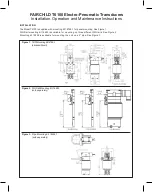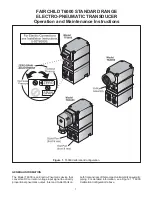
7
Zero Trimming
•
Remove unit from Hazardous Location prior to performing Zero Trimming procedure.
•
Remove the protective screw.
•
Ensure that the transducer is at 0 psig or 0 psia (vacuum if absolute). For compound ranges,
i.e. -15 psi to 30 psi, the 4 mA, 0 V, 0.5 V, or 1 V set point is also at vacuum.
•
Using a jeweler’s screwdriver or a suitable instrument, adjust the “Z” pot until you have a 4
mA, 0 V, 0.5 V, or 1 V output.
NOTE
: You may also return the transducer to the factory for repair and/or adjustment.
IMPORTANT
: Do not make changes to the Span adjustment (the “S” pot to the right, see
Figure 7.1) as part of the zero trimming. The Span should only be changed as part of the
recalibration of a gauge with a known pressure source.
Figure 7.1
Zero & Span
Adjustment
8
Re-Calibration
This procedure requires a known pressure source of at least ±0.1% accuracy in order to fully utilize
the accuracy potential of the transducer. (If not available, you can return it to the factory for re-
calibration.)
•
Remove Unit from Hazardous Location prior to recalibration.
•
Ensure that the transducer is at 0 psig or 0 psia (vacuum if absolute), and adjust zero as per
instructions for zero trimming.
•
Apply full scale pressure to the pressure port and adjust the Span (“S”) pot (on the right of
Figure 7.1) until the full scale signal is reached.
•
Re-check zero and re-adjust the zero (“Z”) pot if required
•
Repeat previous two steps until no further adjustment is required.
NOTE
: You may also return the transducer to the factory for repair and/or adjustment.
9
General Care
Your pressure transmitter is very low maintenance and will need little care. As long as it was
installed correctly, it will need very little care and maintenance. However, in general, you should:
•
Keep the sensor and the area around it generally clean.
•
Avoid applications for which the sensor was not designed, such as extreme temperatures,
contact with incompatible corrosive chemicals, or other damaging environments.
•
Inspect the threads whenever you remove the sensor from duty or change its location.
•
Avoid touching the diaphragm. Contact with the diaphragm, especially with a tool, could
permanently shift the output and ruin accuracy.
•
Cleaning the diaphragm or the diaphragm bore should be done with extreme care. If using a
tool is required, make sure it does not touch the diaphragm.
10
Repair Information
If your pressure transmitter needs repair, contact us via email, phone, or online chat on our
website. We will issue you an RMA number with instructions.
•
Phone: 888-525-7300
•
Email: [email protected]
•
Online chat at www.apgsensors.com
11
Removal Instructions
Removing your pressure transducer from service must be done with care. It’s easy to create an
unsafe situation, or damage your sensor, if you are not careful to follow these guidelines:
•
Make sure the pressure is completely removed from the line or vessel where your sensor is
installed. Follow any and all procedures for safely isolating any media contained inside the line
or vessel.
•
Remove the sensor with an appropriately sized wrench (per your process connection).
•
Clean the sensor’s threads of any sealant compound or tape. Inspect the threads and the
diaphragm for any damage.
•
Store your sensor in a dry place between -40° F and 180° F.
DANGER
: Removing the pressure transmitter while there is still pressure in the line or
vessel could result in injury or death.
IMPORTANT
: Do not adjust Zero or Span potentiometer while your PT-405 is installed in a
Hazardous Location. Removing the protective screws to access the potentiometers invalidates
the Hazardous Location approvals until they are replaced.




















